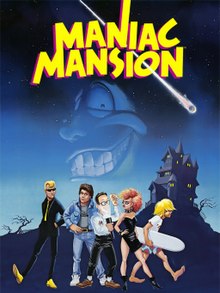
Back مانياك مانسيون ARZ Maniac Mansion Catalan Maniac Mansion Czech Maniac Mansion German Maniac Mansion Greek Maniac Mansion Esperanto Maniac Mansion Spanish Maniac Mansion Basque شیفته عمارت Persian Maniac Mansion Finnish
| Maniac Mansion | |
|---|---|
 Ken Macklin's cover artwork depicts five of the playable characters: Syd, Dave, Bernard, Razor, and Jeff. | |
| Developer(s) |
|
| Publisher(s) | Lucasfilm Games
|
| Designer(s) | Ron Gilbert Gary Winnick |
| Programmer(s) | Ron Gilbert David Fox Carl Mey |
| Artist(s) | Gary Winnick |
| Composer(s) | Chris Grigg David Lawrence
|
| Engine | SCUMM |
| Platform(s) | Commodore 64, Apple II, MS-DOS, Amiga, Atari ST, NES, Macintosh |
| Release | |
| Genre(s) | Graphic adventure |
| Mode(s) | Single-player |
Maniac Mansion is a 1987 graphic adventure video game developed and published by Lucasfilm Games. It follows teenage protagonist Dave Miller as he attempts to rescue his girlfriend Sandy Pantz from a mad scientist, whose mind has been enslaved by a sentient meteor. The player uses a point-and-click interface to guide Dave and two of his six playable friends through the scientist's mansion while solving puzzles and avoiding dangers. Gameplay is non-linear, and the game must be completed in different ways based on the player's choice of characters. Initially released for the Commodore 64 and Apple II, Maniac Mansion was Lucasfilm Games' first self-published product.
The game was conceived in 1985 by Ron Gilbert and Gary Winnick, who sought to tell a comedic story based on horror film and B-movie clichés. They mapped out the project as a paper-and-pencil game before coding commenced. While earlier adventure titles had relied on command lines, Gilbert disliked such systems, and he developed Maniac Mansion's simpler point-and-click interface as a replacement. To speed up production, he created a game engine called SCUMM, which was used in many later LucasArts titles. After its release, Maniac Mansion was ported to several platforms. A port for the Nintendo Entertainment System had to be reworked heavily, in response to Nintendo of America’s concerns that the game was inappropriate for children.[5]
Maniac Mansion was critically acclaimed: reviewers lauded its graphics, cutscenes, animation, and humor. Writer Orson Scott Card praised it as a step toward "computer games [becoming] a valid storytelling art". It influenced numerous graphic adventure titles, and its point-and-click interface became a standard feature in the genre. The game's success solidified Lucasfilm as a serious rival to adventure game studios such as Sierra On-Line. In 1990, Maniac Mansion was adapted into a three-season television series of the same name, written by Eugene Levy and starring Joe Flaherty. A sequel to the game, Day of the Tentacle, was released in 1993.
- ^ "Retrodiary". Retro Gamer (120). Bournemouth, United Kingdom: Imagine Publishing: 13. September 2013.
- ^ Crockford, Douglas. "The Expurgation of Maniac Mansion". Archived from the original on October 12, 2007. Retrieved August 3, 2005.
- ^ "Past Projects: Maniac Mansion". Realtime Associates. Archived from the original on February 7, 2011.
- ^ Maniac Mansion (FC) Credits Screenshot - VGMPF
- ^ "The Expurgation of Maniac Mansion". www.crockford.com. Archived from the original on 2007-10-12. Retrieved 2016-05-30.
© MMXXIII Rich X Search. We shall prevail. All rights reserved. Rich X Search